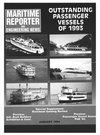
Page 23: of Maritime Reporter Magazine (January 1994)
Read this page in Pdf, Flash or Html5 edition of January 1994 Maritime Reporter Magazine
(Continued from page 7) tended to link the radars of several types of ships and aircraft so a fleet can protect itself better from high- speed missiles.
Also authorized was $240 mil- lion, as requested, to develop a new nuclear submarine. Dubbed Centu- rion, it is intended to be less expen- sive than the two Seawolf-class ships currently under construction. The administration has plans to buy only one more Seawolf.
In a move which reflects the changing world political climate, $50 million was included to adapt exist- ing Los Angeles-class subs for a sonar system designed for the new
Seawolf class. This reflects changes in the Navy's subhunting efforts, from finding Soviet nuclear-pow- ered submarines in the ocean depths to finding other countries' smaller, non-nuclear-powered submarines in relatively shallow water.
Also added to the budget is $10 million to test the ability of powerful computers to make existing sonars on some older ships more effective in detecting submarines in shallow water.
Finally, the bill authorizes the $894 million requested for a heli- copter carrier the size of a medium- sized aircraft carrier. The ship is designed to carry 2,000 Marines, plus helicopters and barges to haul them ashore.
U.S.C.G. Implements
Simplification Of Vessel
Documentation Procedures
The U.S. Coast Guard (USCG) has announced the implementation of new vessel documentation rules that streamline procedures and re- move needless regulations. Thenew rules that become effective January 1, 1994, are more user-friendly and substantially eliminate unnecessary paperwork.
The new procedure will: • reduce required vessel procure- ment forms from more than seven to only two, the application itself and evidence of title; • eliminate the 60,000 plus submis- sions of the MarAd citizenship dec- laration form presently required for certain owners; • eliminate the currently required marking certificates that total more than 45,000 submissions; and, • require only two copies of the
Dreferred mortgage compared with ;he previously-required four.
In addition to simplifying the ves- sel documentation procedures, cer- ;ain regulations are eliminated, ^ow, it will be possible to renew indorsements at any port of docu- nentation and not just in the home >ort. For example, instead of being •estricted to marking the vessel with he USCG port of documentation or he owner's residence, the owner nay choose from more than 190,000 (laces.
The USCG's new regulations re- ult in a simpler application pro- ess. Therefore, inadvertent omis- ions will no longer automatically oid the application. This will result ii fewer rejections. anuary, 1994
In order to meet the expenses associated with providing these en- hanced services, the USCG is apply- ing a reasonable user fee that more accurately reflects the cost of the service. The fee, required by the statute, will be determined by the type of endorsement requested and no fee will be charged for the re- newal of an endorsement.
For further information, contact
Commandant, U.S. Coast Guard
Headquarters, Office of Marine
Safety, Security and Environmen- tal Protection (G-MVI-5), 2100 Sec- ond St., S.W., Washington, D.C. 20593-0001 or (202) 267-1492.
MarAd Honors U.S.-Flag
Shippers
In ceremonies held in Houston and Atlanta on December 1st and 8th, respectively, the U.S. Government formally thanked 114 exporters and importers for patronizing U.S.-flag merchant ships. "Through their use of America's merchant ships, these companies support the nation's economic security and vital sealift capability," said Albert J.
Herberger, Maritime Administra- tor. "America needs commercial cargo ships and civilian seafarers for military support and to avoid being totally dependent upon for- eign ships and crews to support the growth of our foreign trade." Mr.
Herberger personally thanked the shippers at the ceremonies, and each received the Department of
Transportation's U.S. Merchant
Marine Certificate of Appreciation.
When someone asks to use the phone, here's your answer.
CallAboard® provides public cellular telephone service for ferries, cruise ships, gambling vessels, dining yachts, work barges, island locations and other remote environments where conventional wired telephone service is not available. • Free public cellular telephones • Monthly commissions* • No long-term financial obligations • Immediate hook-up • No phone bills to handle • No administrative burden csjesS^
Callers may charge phone calls directly to their major credit cards, phone company calling card, or call collect
Billing information can be entered through the keypad, card reader, or given to live operators
CallAboard® provides the best way for passengers, customers, and employees to stay in telephone contact without costing most companies any money. We deliver state-of-the-art public cellular telephone equipment, installation, service and bill processing FREE of charge to qualified organizations.**
CallAboard® eliminates any need to time calls, oversee billing, perform service or attempt collection. CallAboard® will handle all of your public cellular communication needs and allow everyone to keep in touch!
CallAboard
A Service of CELLNET Corporation
Call 1-800-CallAboard a-800-225-5226-273) 400 Main Street, Suite 800, Stamford, CT 06901 -3004 Fax (203) 359-6826 • Call (203) 359-6333, Ext. 304 or 307 * Commission schedule will commence when phone usage exceeds monthly minimum. ** Based upon applicant's qualifications and specific application.
Circle 287 on Reader Service Card

 22
22

 24
24
